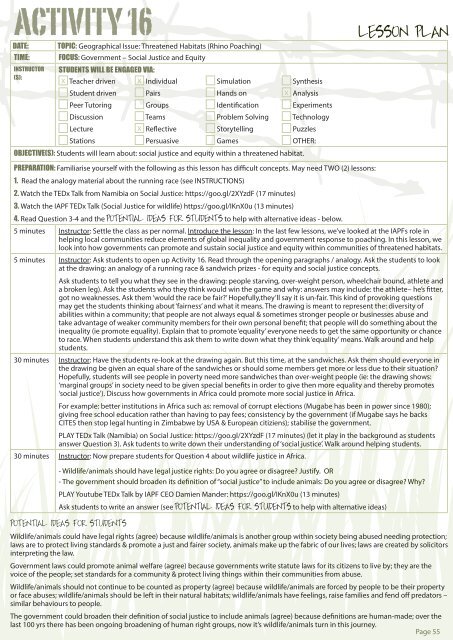You also want an ePaper? Increase the reach of your titles
YUMPU automatically turns print PDFs into web optimized ePapers that Google loves.
ACTIVITY 16<br />
DATE:<br />
TOPIC: Geographical Issue: Threatened Habitats (Rhino Poaching)<br />
TIME:<br />
INSTRUCTOR<br />
(S):<br />
FOCUS: Government – Social Justice and Equity<br />
STUDENTS WILL BE ENGAGED VIA:<br />
x <strong>Teacher</strong> driven x Individual<br />
Student driven<br />
Peer Tutoring<br />
Discussion<br />
Lecture<br />
Stations<br />
Pairs<br />
Groups<br />
Teams<br />
x Reflective<br />
Persuasive<br />
Simulation<br />
Hands on<br />
Identification<br />
Problem Solving<br />
Storytelling<br />
Games<br />
Synthesis<br />
x Analysis<br />
OBJECTIVE(S): Students will learn about: social justice and equity within a threatened habitat.<br />
Experiments<br />
Technology<br />
Puzzles<br />
OTHER:<br />
LESSON PLAN<br />
PREPARATION: Familiarise yourself with the following as this lesson has difficult concepts. May need TWO (2) lessons:<br />
1. Read the analogy material about the running race (see INSTRUCTIONS)<br />
2. Watch the TEDx Talk from Namibia on Social Justice: https://goo.gl/2XYzdF (17 minutes)<br />
3. Watch the IAPF TEDx Talk (Social Justice for wildlife) https://goo.gl/IKnX0u (13 minutes)<br />
4. Read Question 3-4 and the POTENTIAL IDEAS FOR STUDENTS to help with alternative ideas - below.<br />
5 minutes Instructor: Settle the class as per normal. Introduce the lesson: In the last few lessons, we’ve looked at the IAPFs role in<br />
helping local communities reduce elements of global inequality and government response to poaching. In this lesson, we<br />
look into how governments can promote and sustain social justice and equity within communities of threatened habitats.<br />
5 minutes Instructor: Ask students to open up Activity 16. Read through the opening paragraphs / analogy. Ask the students to look<br />
at the drawing: an analogy of a running race & sandwich prizes - for equity and social justice concepts.<br />
Ask students to tell you what they see in the drawing: people starving, over-weight person, wheelchair bound, athlete and<br />
a broken leg). Ask the students who they think would win the game and why: answers may include: the athlete– he’s fitter,<br />
got no weaknesses. Ask them ‘would the race be fair?’ Hopefully,they’ll say it is un-fair. This kind of provoking questions<br />
may get the students thinking about ‘fairness’ and what it means. The drawing is meant to represent the: diversity of<br />
abilities within a community; that people are not always equal & sometimes stronger people or businesses abuse and<br />
take advantage of weaker community members for their own personal benefit; that people will do something about the<br />
inequality (ie promote equality). Explain that to promote ‘equality’ everyone needs to get the same opportunity or chance<br />
to race. When students understand this ask them to write down what they think ‘equality’ means. Walk around and help<br />
students.<br />
30 minutes Instructor: Have the students re-look at the drawing again. But this time, at the sandwiches. Ask them should everyone in<br />
the drawing be given an equal share of the sandwiches or should some members get more or less due to their situation?<br />
Hopefully, students will see people in poverty need more sandwiches than over-weight people (ie: the drawing shows:<br />
‘marginal groups’ in society need to be given special benefits in order to give then more equality and thereby promotes<br />
‘social justice’). Discuss how governments in Africa could promote more social justice in Africa.<br />
For example: better institutions in Africa such as: removal of corrupt elections (Mugabe has been in power since 1980);<br />
giving free school education rather than having to pay fees; consistency by the government (if Mugabe says he backs<br />
CITES then stop legal hunting in Zimbabwe by USA & European citiziens); stabilise the government.<br />
PLAY TEDx Talk (Namibia) on Social Justice: https://goo.gl/2XYzdF (17 minutes) (let it play in the background as students<br />
answer Question 3). Ask tudents to write down their understanding of ‘social justice’. Walk around helping students.<br />
30 minutes Instructor: Now prepare students for Question 4 about wildlife justice in Africa.<br />
- Wildlife/animals should have legal justice rights: Do you agree or disagree? Justify. OR<br />
- The government should broaden its definition of “social justice” to include animals: Do you agree or disagree? Why?<br />
PLAY Youtube TEDx Talk by IAPF CEO Damien Mander: https://goo.gl/IKnX0u (13 minutes)<br />
Ask students to write an answer (see POTENTIAL IDEAS FOR STUDENTS to help with alternative ideas)<br />
POTENTIAL IDEAS FOR STUDENTS<br />
Wildlife/animals could have legal rights (agree) because wildlife/animals is another group within society being abused needing protection;<br />
laws are to protect living standards & promote a just and fairer society, animals make up the fabric of our lives; laws are created by solicitors<br />
interpreting the law.<br />
Government laws could promote animal welfare (agree) because governments write statute laws for its citizens to live by; they are the<br />
voice of the people; set standards for a community & protect living things within their communities from abuse.<br />
Wildlife/animals should not continue to be counted as property (agree) because wildlife/animals are forced by people to be their property<br />
or face abuses; wildlife/animals should be left in their natural habitats; wildlife/animals have feelings, raise families and fend off predators –<br />
similar behaviours to people.<br />
The government could broaden their definition of social justice to include animals (agree) because definitions are human-made; over the<br />
last 100 yrs there has been ongoing broadening of human right groups, now it’s wildlife/animals turn in this journey.<br />
Page 55



